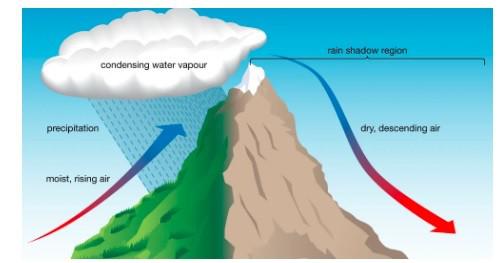Mains Daily Question
Dec. 14, 2023
Q3. What does the term "cloud burst" mean and how is it different from regular rainfall. Describe the devastating impacts of cloudburst on the area of its occurrence. (10M, 150W)
|
Approach to the Answer: Understanding and structuring the answer: The question has three main headings: 1) cloudburst 2) difference between cloudburst and rainfall 3) impacts of cloudburst Introduction: Type 1: Introduce with definition of cloudburst in brief or Type 2: Can start with any recent news/report of cloudburst in India or around the world. Body: Heading 1: Briefly write about the reasons for its occurrence. Heading 2: Mention how a cloudburst is different from rainfall. Heading 3: Write the impacts of cloudburst including examples Conclusion: Type 1: Conclude way forward or Type 2: Can finish with writing its devastation for human, flora and fauna. |
Answer: Cloudburst, a geo-hydrological hazard, refers to a sudden and heavy rainfall that takes place within a short span of time and a particular region. The intensity of rainfall is often more than 100mm per hour according to (IMD). A cloudburst can be very dangerous as it commonly sweeps away people, animals, and portions of land on its way.
Reasons behind cloudbursts:
Cloudbursts usually happen in mountainous regions due to orography. It occurs when warm air current from the ground or below the clouds rushes up and carries the falling raindrops up with it. As a result, new raindrops that are formed are heavier and denser. After a point, the raindrops become too heavy for the cloud and they fall down together in a short period over a small area, causing a cloudburst.
Cloudburst different from rainfall
- Character: Rain is condensed water falling from a cloud which may or may not be intense, however a cloudburst in a sudden heavy downpour.
- Classification: Heavy rainfall can be classified as a cloudburst only if it occurs 100mm per hour according to IMD.
- Prediction: It is very difficult to predict cloudbursts due to its very small scale in space and time.
Impacts of Cloudburst:
- Flash flood: A cloudburst can have disastrous effects, such as flash floods. These floods have the ability to uproot trees and displace boulders and other debris.
- For example, a cloudburst triggered flash floods in Ladakh’s Kargil district in mid-2022
- Landslides: Because of the nature of the terrain, heavy rainfall events often trigger landslides, causing extensive destruction downstream.
- For example, several people were killed in landslide in Himachal Pradesh in July 2022.
- Damage to infrastructure: Because of the enormous amount of rainfall associated with cloudbursts, it can also cause damage to homes, highways, and bridges.
- Health effect: Waterlogging due to cloudbursts may cause the spread of water-borne diseases.
Cloudburst is a natural phenomenon, but it occurs quite unexpectedly, very abruptly, and rather drenching. In the Indian Subcontinent, its intensity and frequency are increasing. Since they cannot be predicted, a flood warning in a way can be taken as a cloudburst warning too, and people need to be better prepared during monsoon months.


